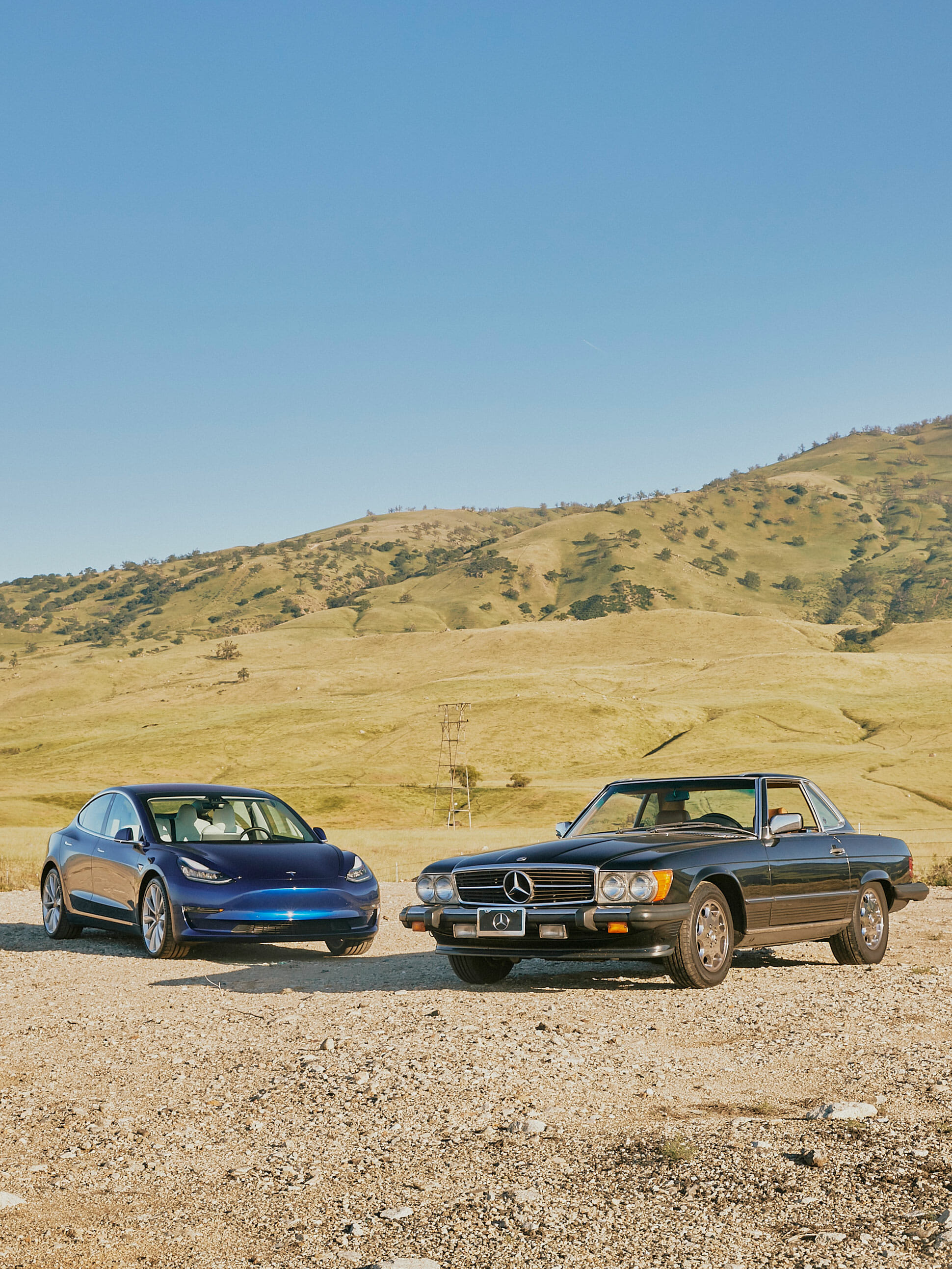Tesla Model 3 vs. 1987 Mercedes-Benz 560 SL: One Hell of an Unorthodox Comparison
A version of this article originally appeared in Issue Ten of Gear Patrol Magazine with the headline “The Future Perfect.” Subscribe today
The future is smart. It’s learned to sneak up on us so that we don’t overreact and start lighting things on fire. When the news hit that self-driving cars were not only real but heading our way, fast, we were too busy chasing cartoon holograms on our phones to care much. Our collective response to a sci-fi dream going back a hundred years was a collective, petulant shrug. The future, being smart, chose to reveal itself at a time when we are easily delighted with technology and almost never impressed by it.
But it’s not just autonomy, whenever that comes, that’s changing the car. It’s electrification, battery power with instant torque and dirt-cheap energy. It’s the erosion of the ownership model and the rise of a connected car that can communicate with other vehicles on the road and the surrounding infrastructure. The idea of what a car can be has never been so up in the air, even back when the automobile was first invented.
Most people don’t care. They just want to get to work and back. But the promise of the American automobile has always been freedom — the idea that at any time you can head off into this huge, wild country under your own steam, beholden to no one. Can that dream survive in a rolling computer packed with sensors, constantly monitoring you, relaying not just your location but where you stopped for lunch and what you’re listening to on the radio?
I want to know what we’re trading for it, this safe, connected, convenient, hardworking car of the future, so I’m heading to California, spiritual home of the American road trip. I’ve sourced an old fast car, sleek and elegant and utterly brainless, to drive from LA to Silicon Valley, and the absolute newest, most futuristic vehicle on the market to drive me back. In between, I want a glimpse of what we’re being promised — and what, exactly, we’ll be expected to give up for it.
PART 1: Los Angeles to Fremont
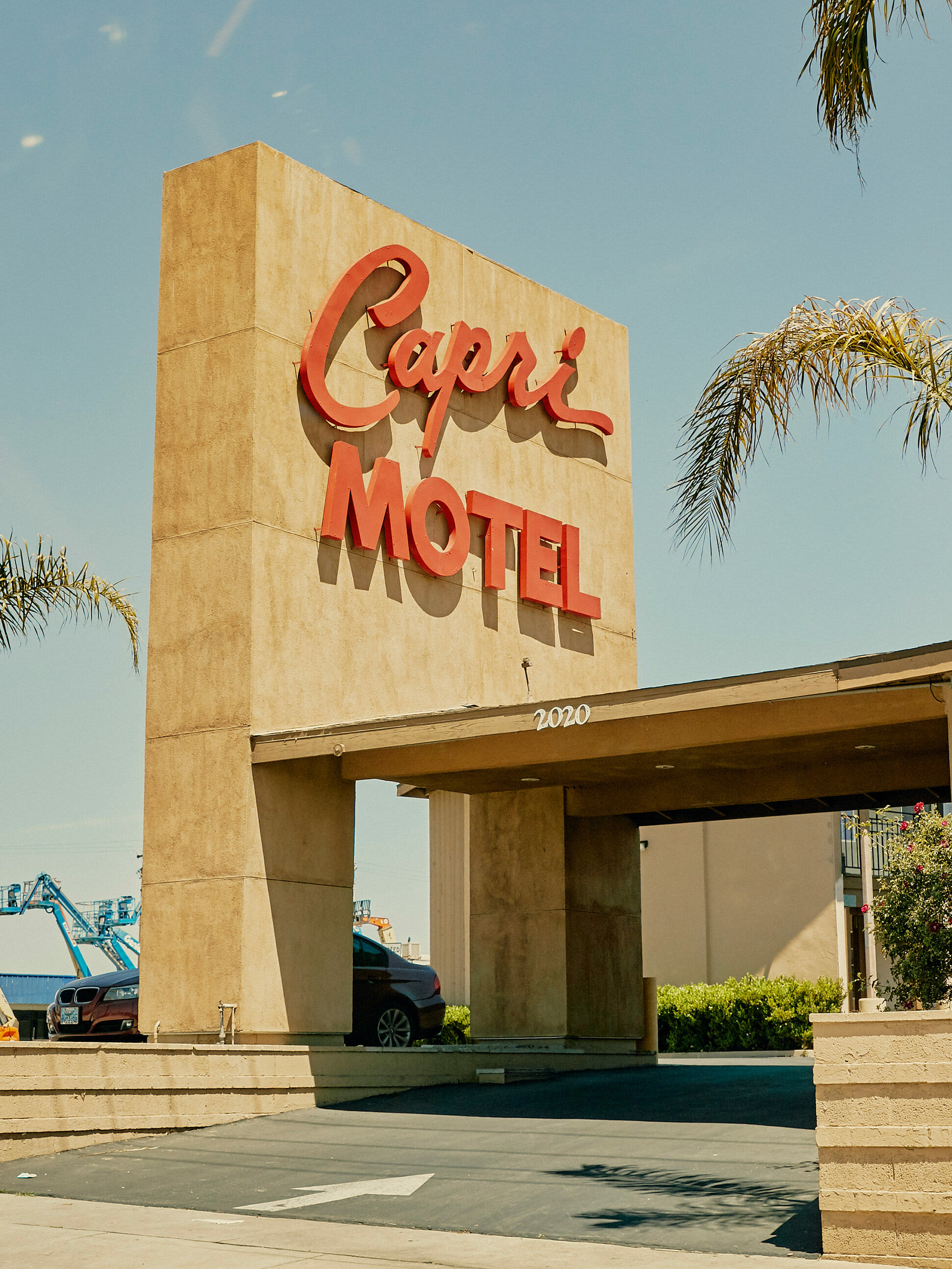
1987 Mercedes-Benz 560 SL
In the sunset days of Reagan’s Morning in America, before Straight Outta Compton and what we know as the internet, when you could still smoke on planes and get shot at the Berlin Wall, a brand-new 1987 Mercedes-Benz 560 SL offered modern amenities like power windows and a cassette player. It came with a large, sturdy German engine and a thin metal key to start it. Safety technology consisted of seat belts, anti-lock brakes and an airbag. At the time, it cost around half the price of a new home in the U.S.
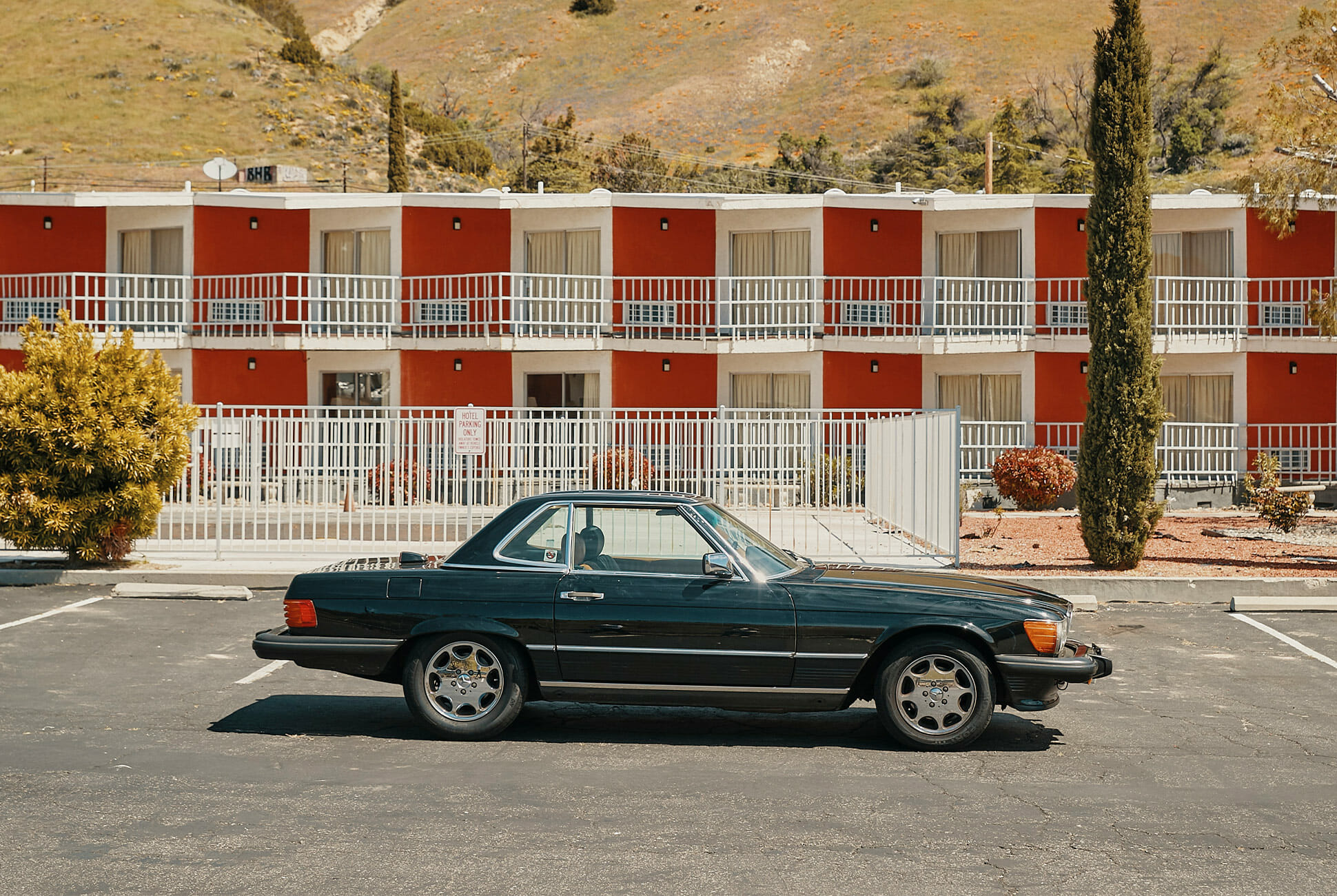
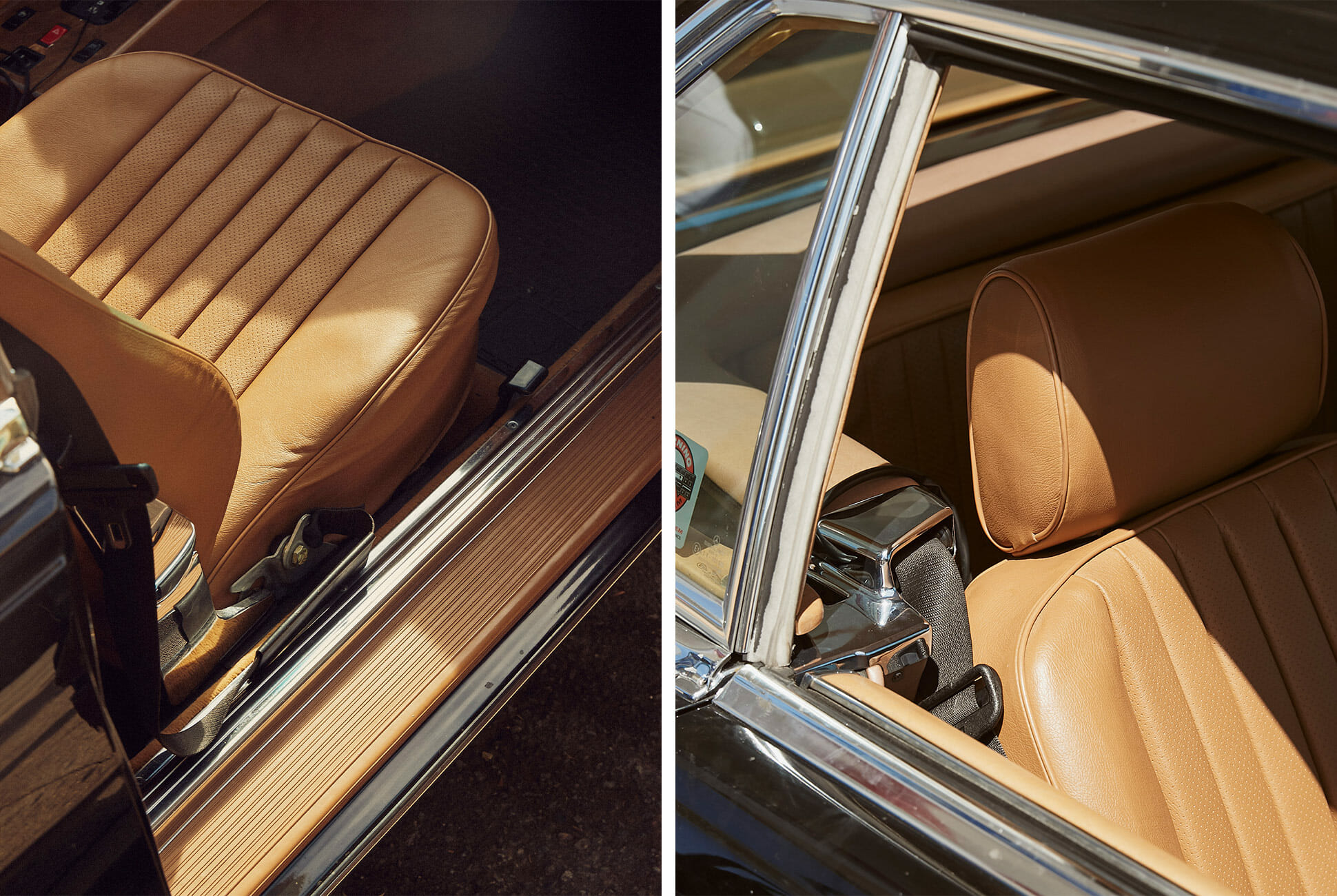
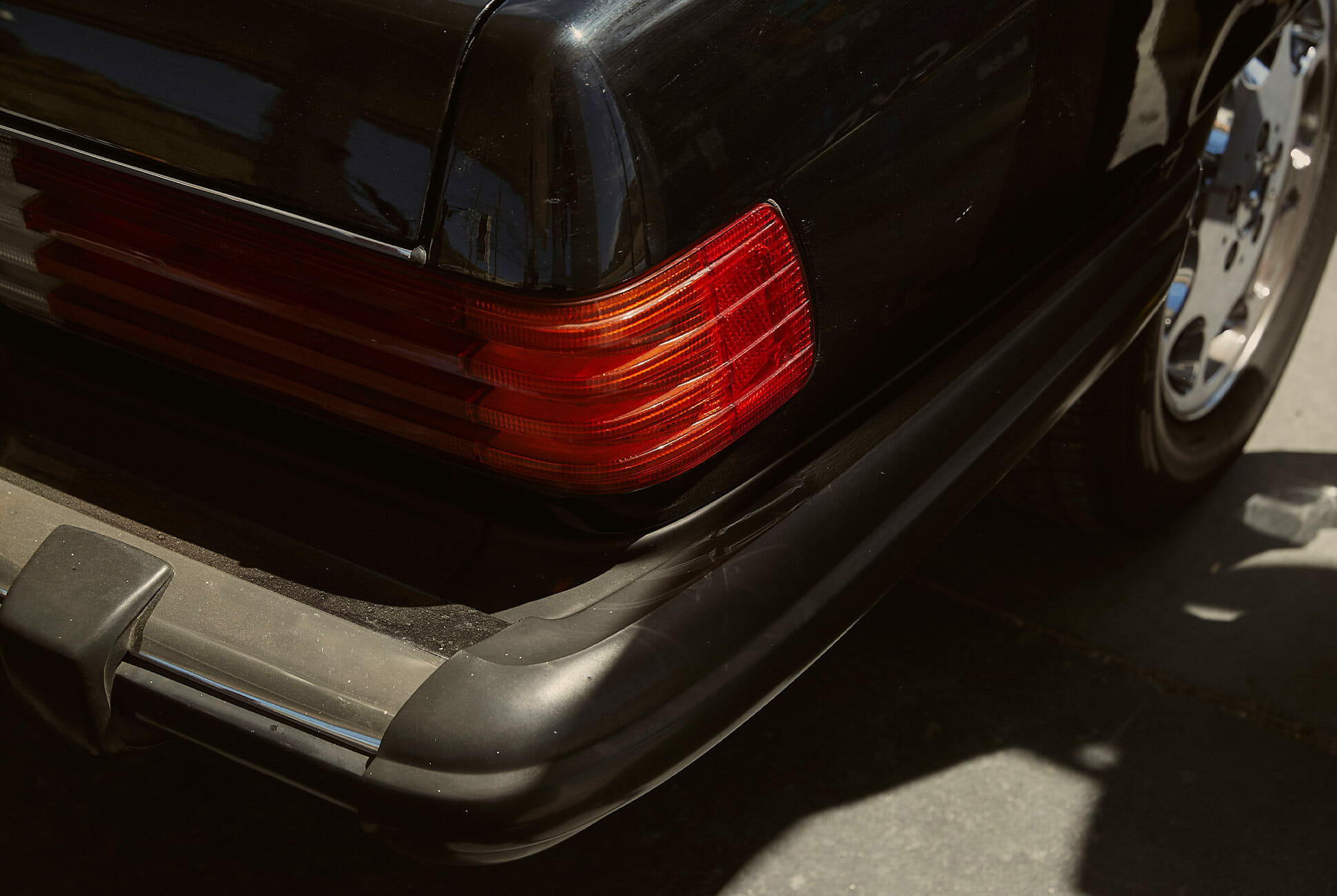
This is the car I pick up 32 years later, in a leafy residential stretch off Wilshire Boulevard, in LA — a low, polished black sled with the moneyed swag of a horsebit loafer. The cockpit appears airy, delicate, like the greenhouse canopy of an old Zero fighter plane. The inside is covered in well-massaged leather and shiny old wood. There’s a 227-horsepower V8 in the long nose and rear-wheel drive in the back, and the car jumps like a spooked cat when you stomp the gas.
We point it north from LA, towards Bakersfield. The coupe barrels through the hot air like a hurled brick. The 560 SL was born before the modern art of aerodynamic modeling and it’s better for it, the beltline so low your arm can’t help but hook itself out the window. The windshield’s curved glass frames the world like a viewfinder.
Age has robbed the seats of their posture; they sag, and the leather bakes immediately in the heat. On our way out of LA, we scroll the AM/FM dial, trying to guess our way to some period-correct ‘80s music but settling for whatever comes through clear.
The radio grows shy as we move inland through the hot, kaleidoscopically brown parts of southern California. I shut it off and listen to the car instead. The motor has a soft steady chug and the suspension sighs over fast crests. The tires drum a constant low hum into the cockpit and any adjustment fills the space with the clack of buttons and dials and levers. Even mostly alone in the midday desert, the car has the false quiet of a city apartment.
The 560 SL settles into a nice canter around 80 mph. I settle in, too, watch my arm turn sunburned as McFarland becomes Delano becomes Pixley becomes Tripton. I cast around the cabin at the various surfaces — metal, leather, veneered wood, glass, plastic, cloth — and at the handsome, analog gauges and the thin needles that hover at some vague approximation of speed or RPM.
Uninterrupted hours of highway driving requires a sort of meditation, an ability to maintain concentration through stillness, because there’s almost nothing to it: minute adjustments to the wheel or the gas, the occasional glance in a mirror.
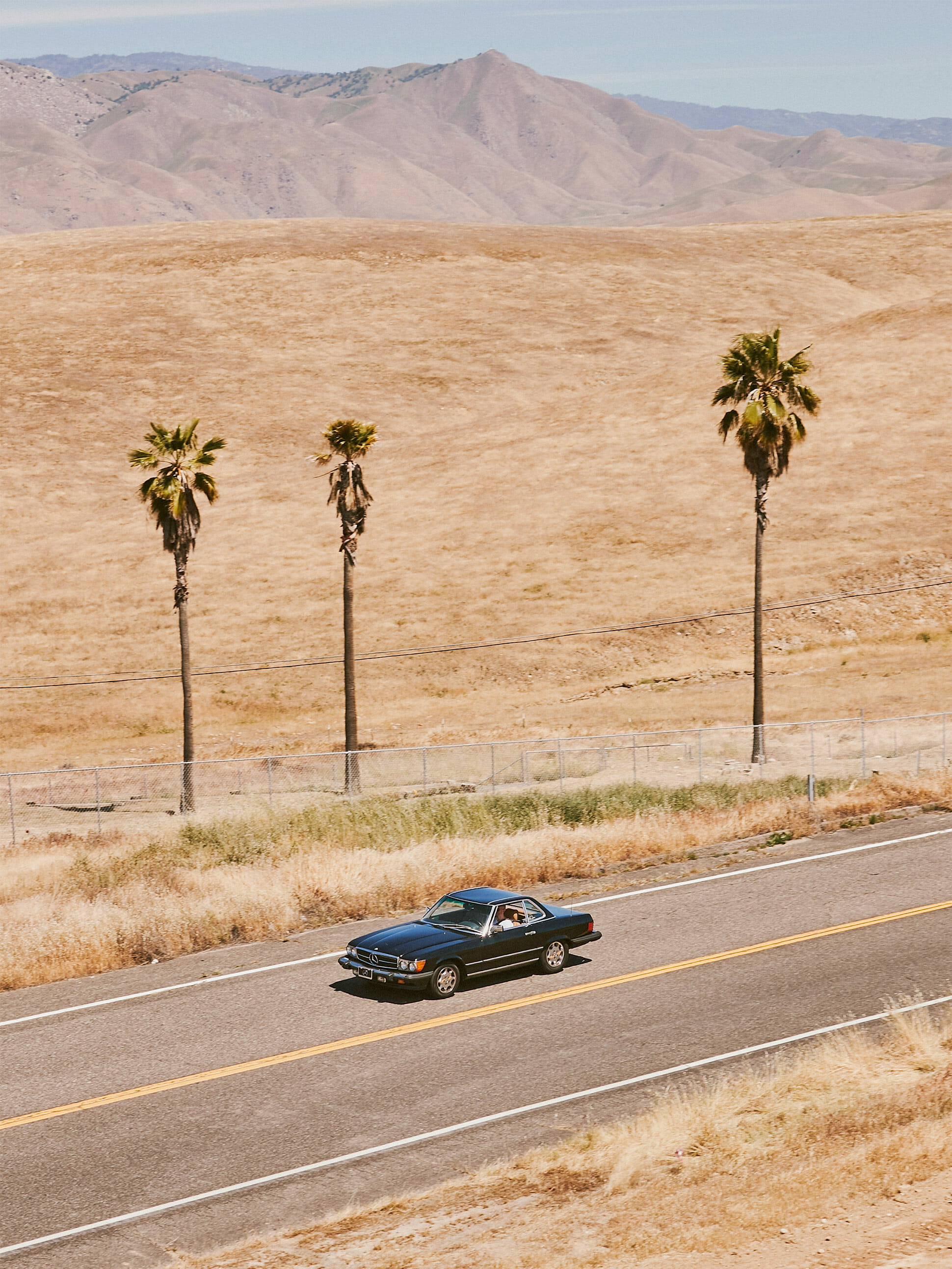
But within the stillness there’s a subtle conversation taking place between me and the Merc. I tell it where to go and how fast to get there; the car tells me about the condition of the pavement, any irregularities or debris in the road, available tire grip. Even with hydraulic assist, the rack-and-pinion steering is hardly more complicated than a wheel and axle, but it offers something the most advanced cars on the market today cannot: a physical connection to the road, linked from the tires through a series of rods, knuckles, joints, pistons and shafts up through the steering wheel and into my fingertips.
The steering is fuzzy and wanders after grooves in the pavement. The steady sound of the engine chugging tells me it’s breathing well; the travel of the brake pedal indicates how much stop is left in it.
Enthusiasts venerate these sensations but most people can’t translate them, like trying to explain the taste of good wine. The degree and detail of this feedback separates a good car from a great car from a sublime car. But it’s also work: the baseline attention and constant microadjustments needed to keep a car on course becomes tiring, and as we make our way past Fresno I feel the first fuzzy creep of fatigue.
We drive through Herndon, through Fairmead, turn west on the 152 just south of Chowchilla, stop at one of the thousands of gas stations in the state and perform the same rituals: swipe the card, pump the gas, wander past the burnt coffee.
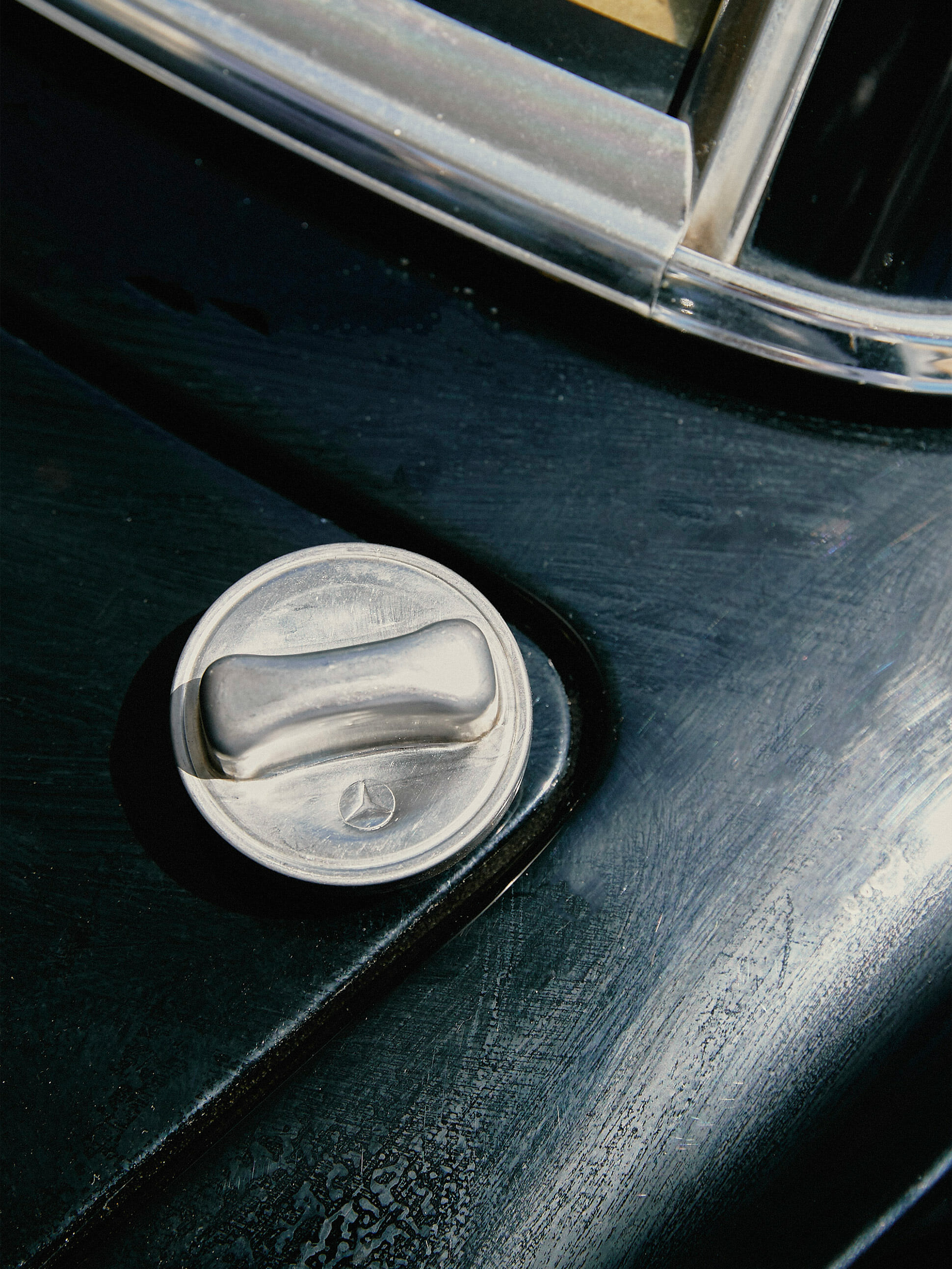
It’s a pristine example of the modern American gas station, a wide, bright, depressing junk food aisle with a side hustle in cigarettes and lottery tickets. It’s not a place meant for lingering but I’m thirsty and the car’s hot. I get a couple thumbs up from Leno fans for choosing something old and sufficiently difficult. The Merc has less horsepower than a new six-cylinder Toyota Camry, and all things being square, any modern crossover will utterly thrash it around a racetrack, but when I stretch I can still feel the road in my hands and the churn of the engine under throttle.
After five hours in the car, its personality has vibrated into my bones — the long brakes and loose steering, the way the suspension dips and rolls through corners. I told it where to go and how fast to get there, and it gave me 227 horsepower and a four-speed automatic to use as I pleased.

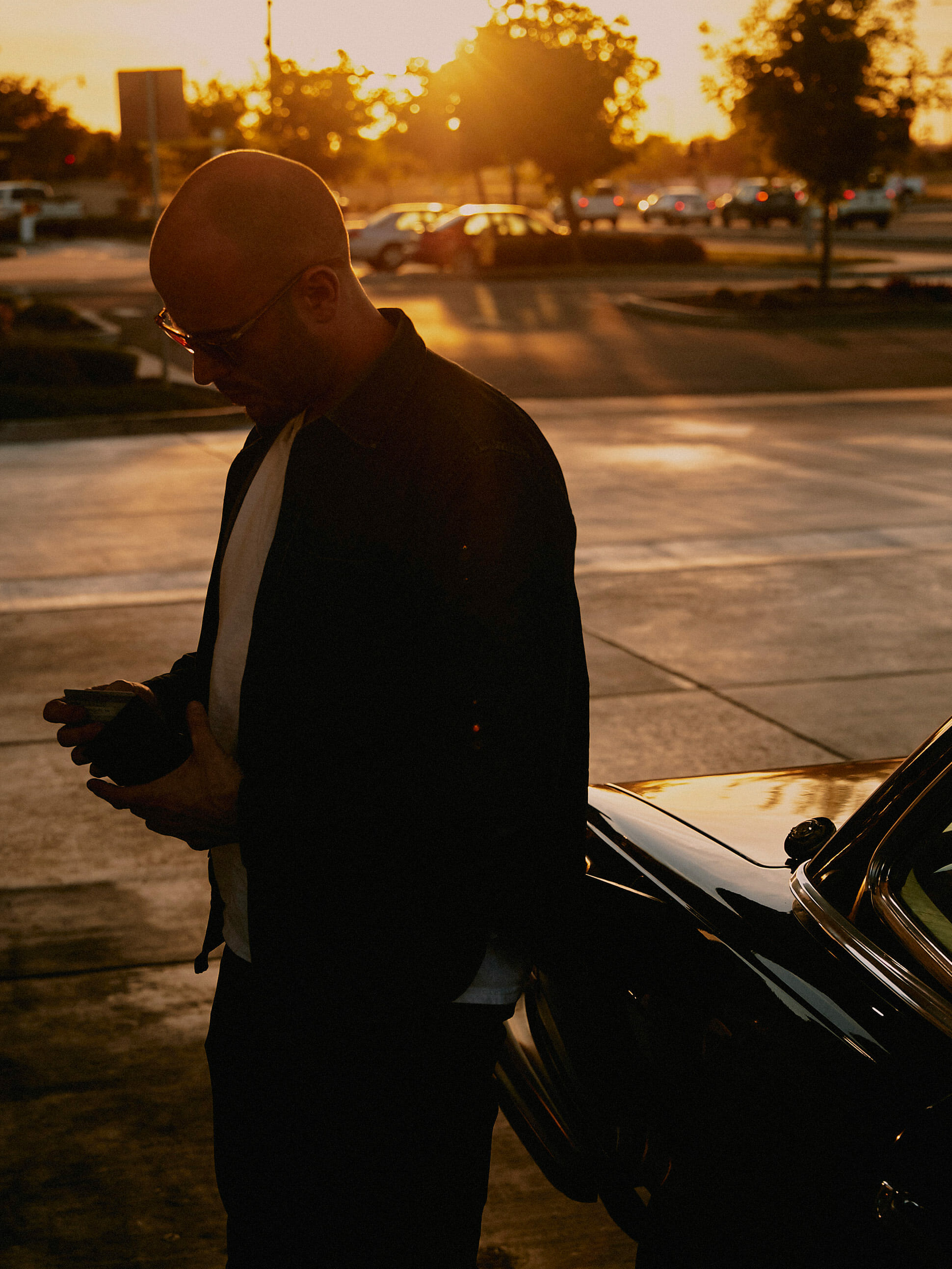
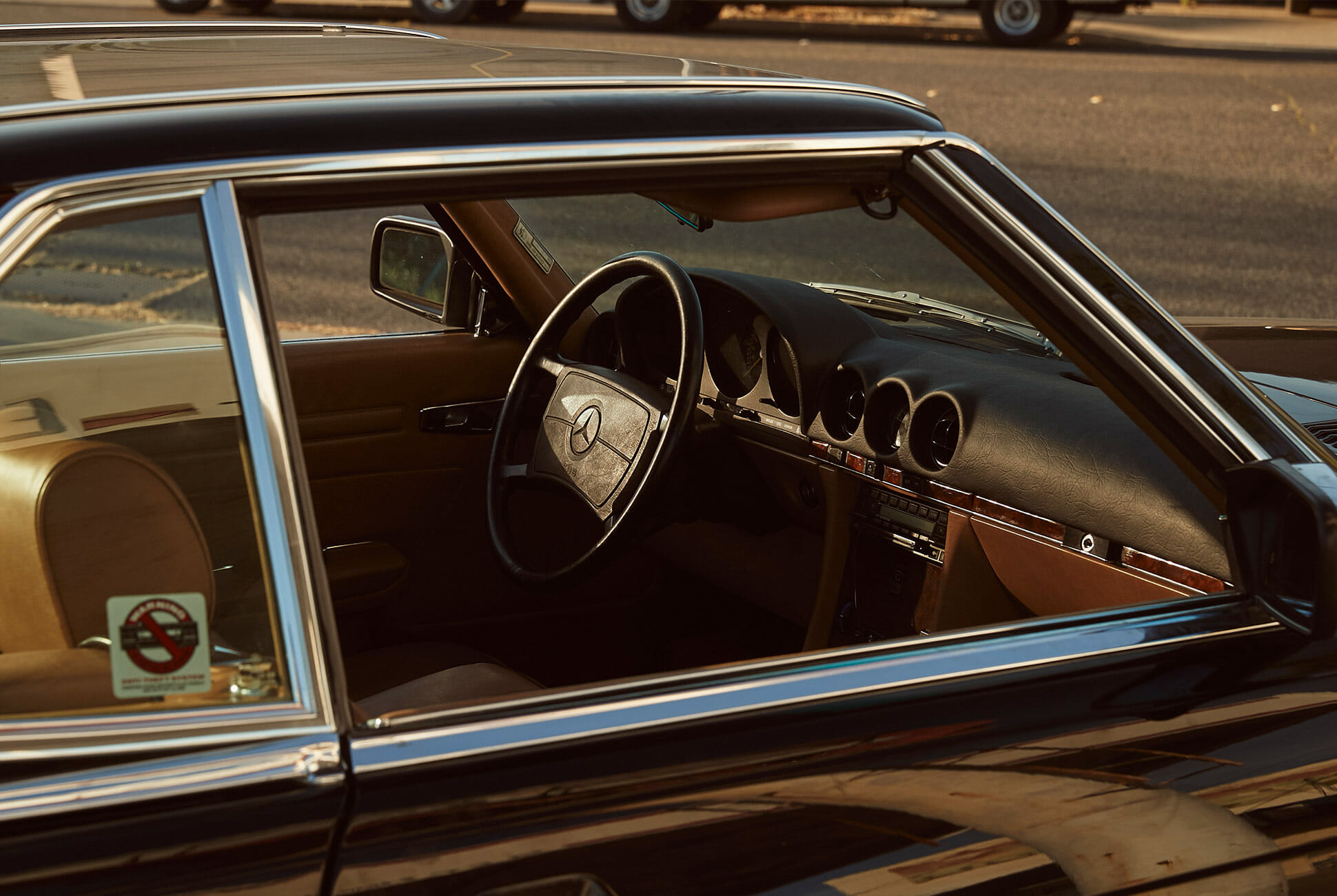
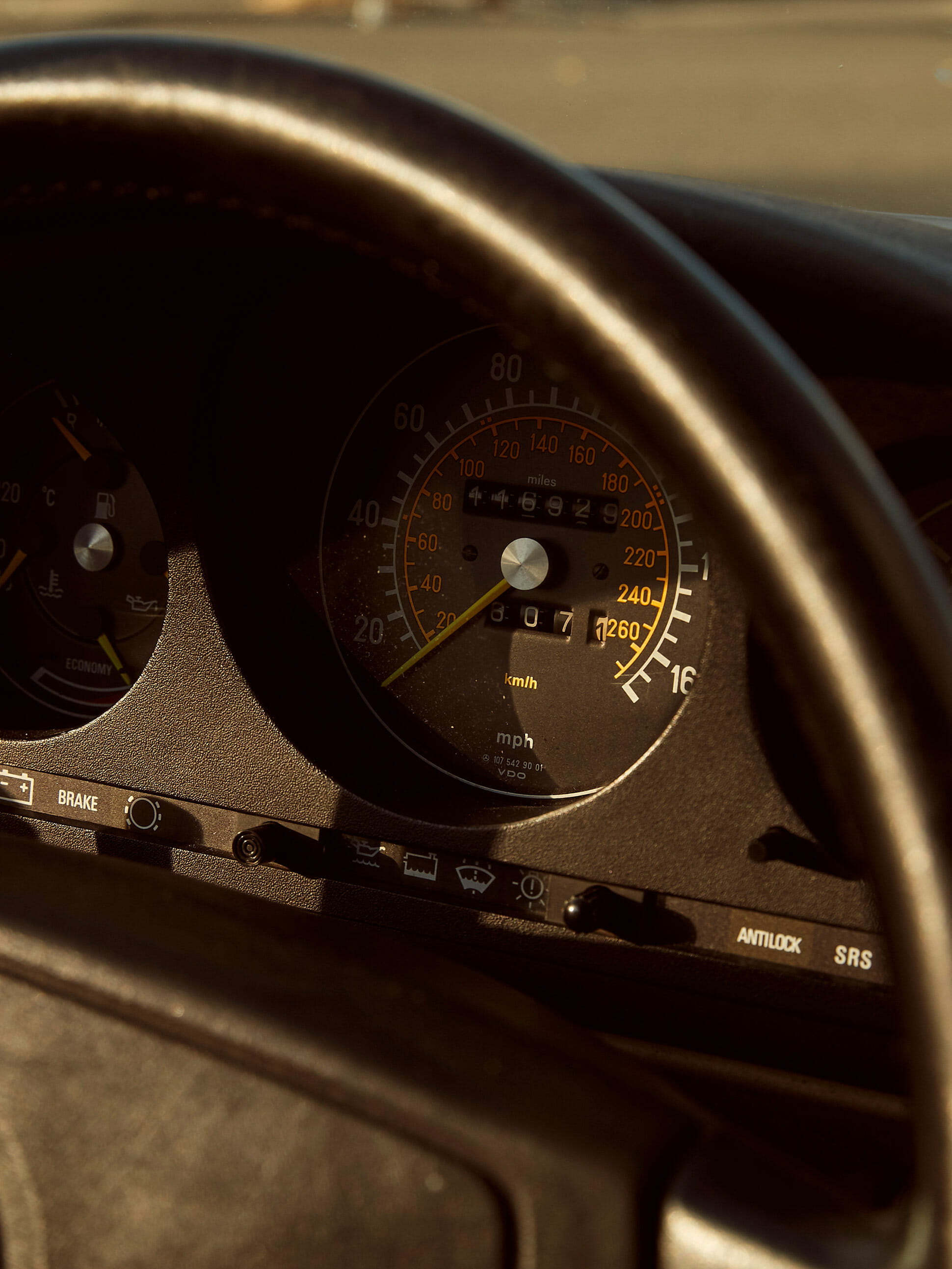
Back on the road the FM picks up staticky blues as we roll into Fremont, the music pulled out the open windows and tossed into the breeze. It strikes me that if I tossed my phone out alongside it I would be nearly in the wind. The old Merc’s airy, delicate cabin is a bunker of its own sort, utterly impenetrable by phone or email or text. Once, back when no one could call you if they didn’t know where you were, cars were a moving target, hard to hit. Now, we go on vacations and retreats and social media fasts just to unplug the way the average American commuter did five days a week some 30-odd years ago.
But I’m tired when I park the car in the sprawling lot, so I pull out my phone and drop a pin to the car’s location, since it won’t do it for me. Technology ain’t all bad.
PART II: Fremont to Los Angeles

2019 Tesla Model 3 Performance
Pinning the throttle in the Tesla Model 3 is something like what hitting hyperspeed looks like on TV: there’s a silent whump and then at some point you realize you’re pulling a stupid face with your mouth hanging open and you’re maybe in another zip code.
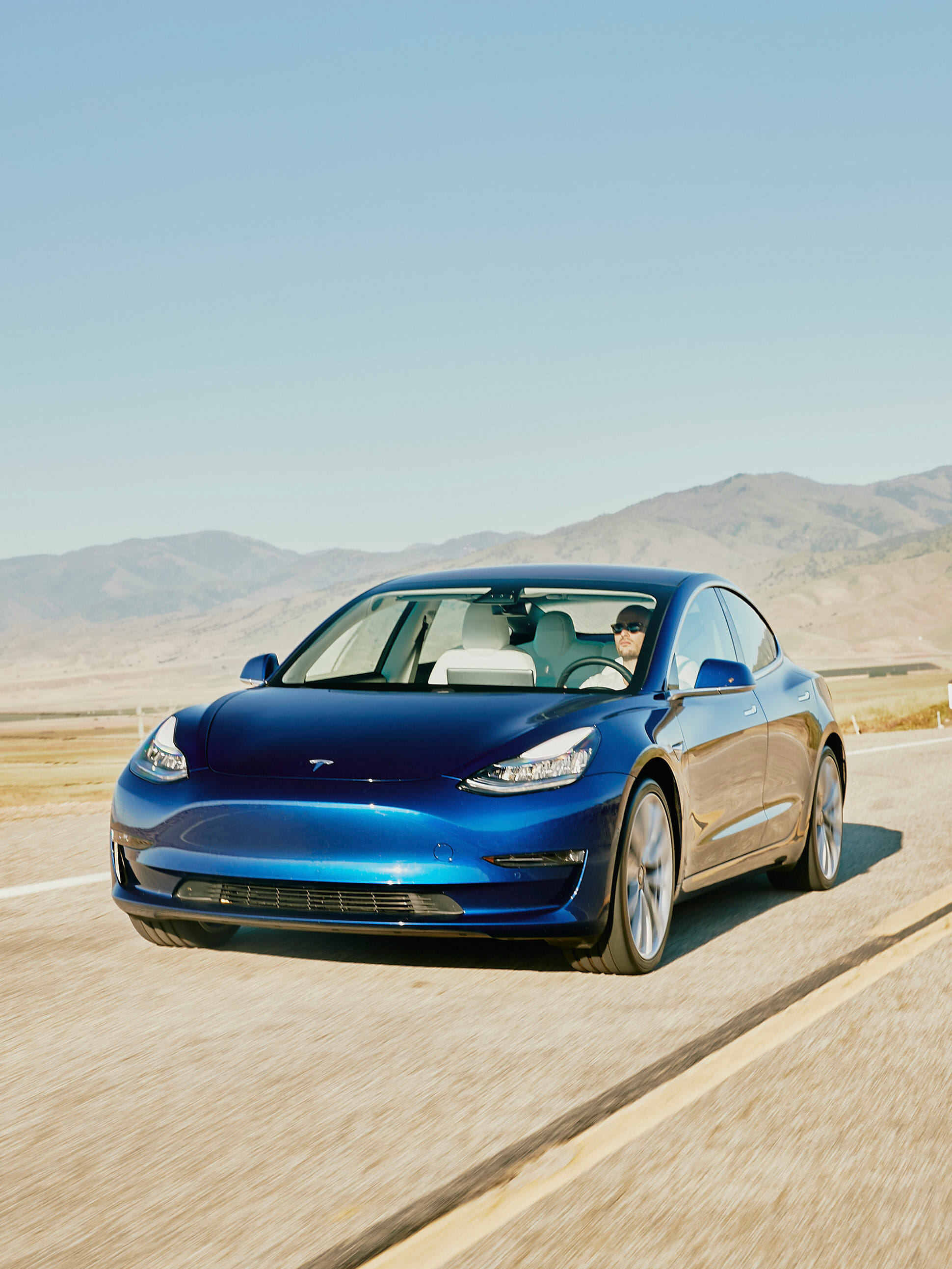
Before we get into anything else, the weird shape or the “self-driving” or the hermetically clean interior, it should be noted that the Tesla Model 3 Performance is a car you can drive mercilessly, viciously and without sympathy. It’s delightful, stupid, knee-slapping fun — all-wheel drive, beefy
brakes and an extremely low center of gravity. It’s one of the most aerodynamic production cars in the world, with instantaneous torque and a dedicated track mode developed by racing champ Randy Pobst. It embarrasses supercars on the drag strip and can smack around high-priced sports sedans on a road course, for around $60K. If Enzo Ferrari or Carroll Shelby had access to the Model 3, they would have never pursued internal combustion. Like using a stopwatch to time an explosion, it’s hard for human senses to comprehend just how fast the car is.
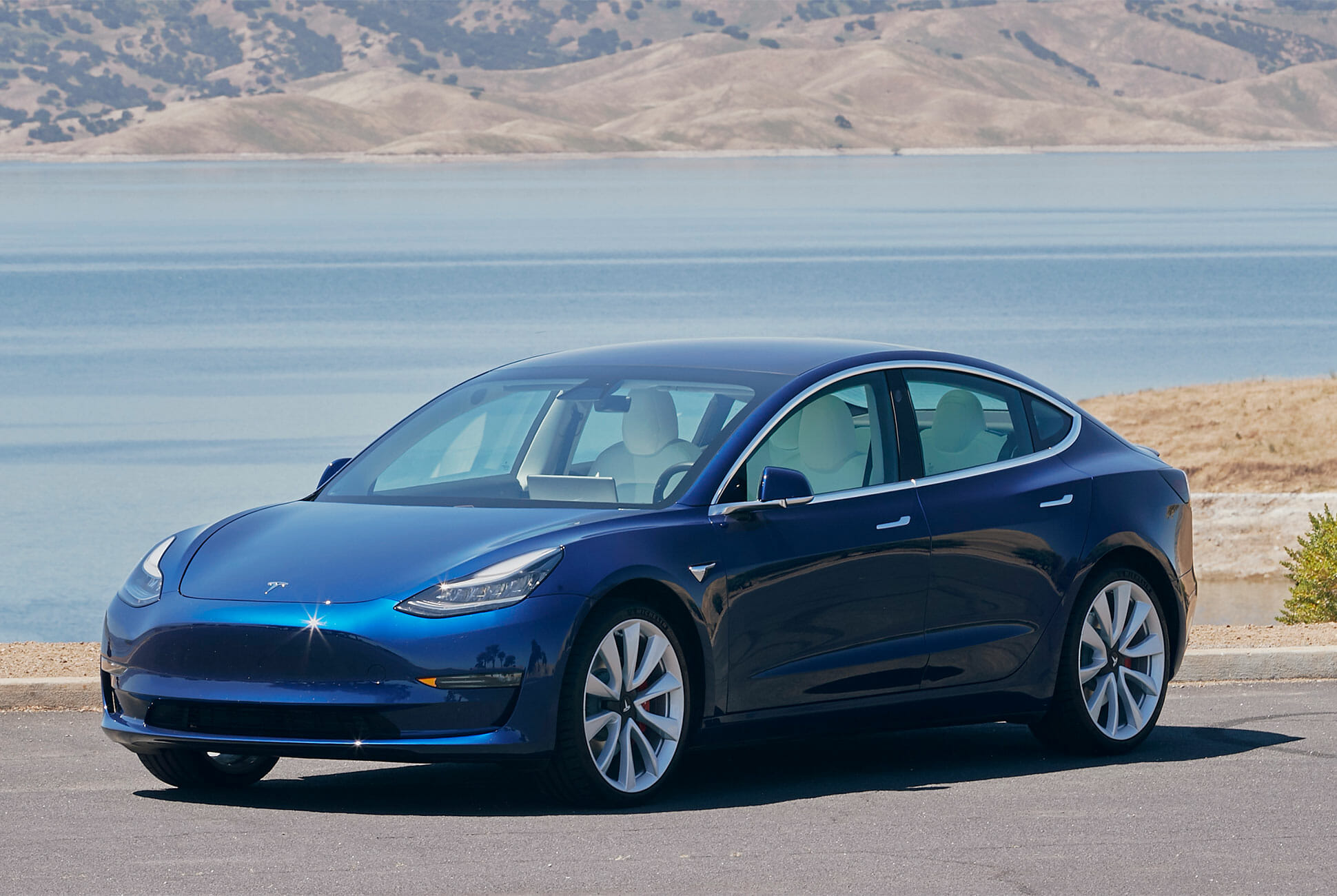
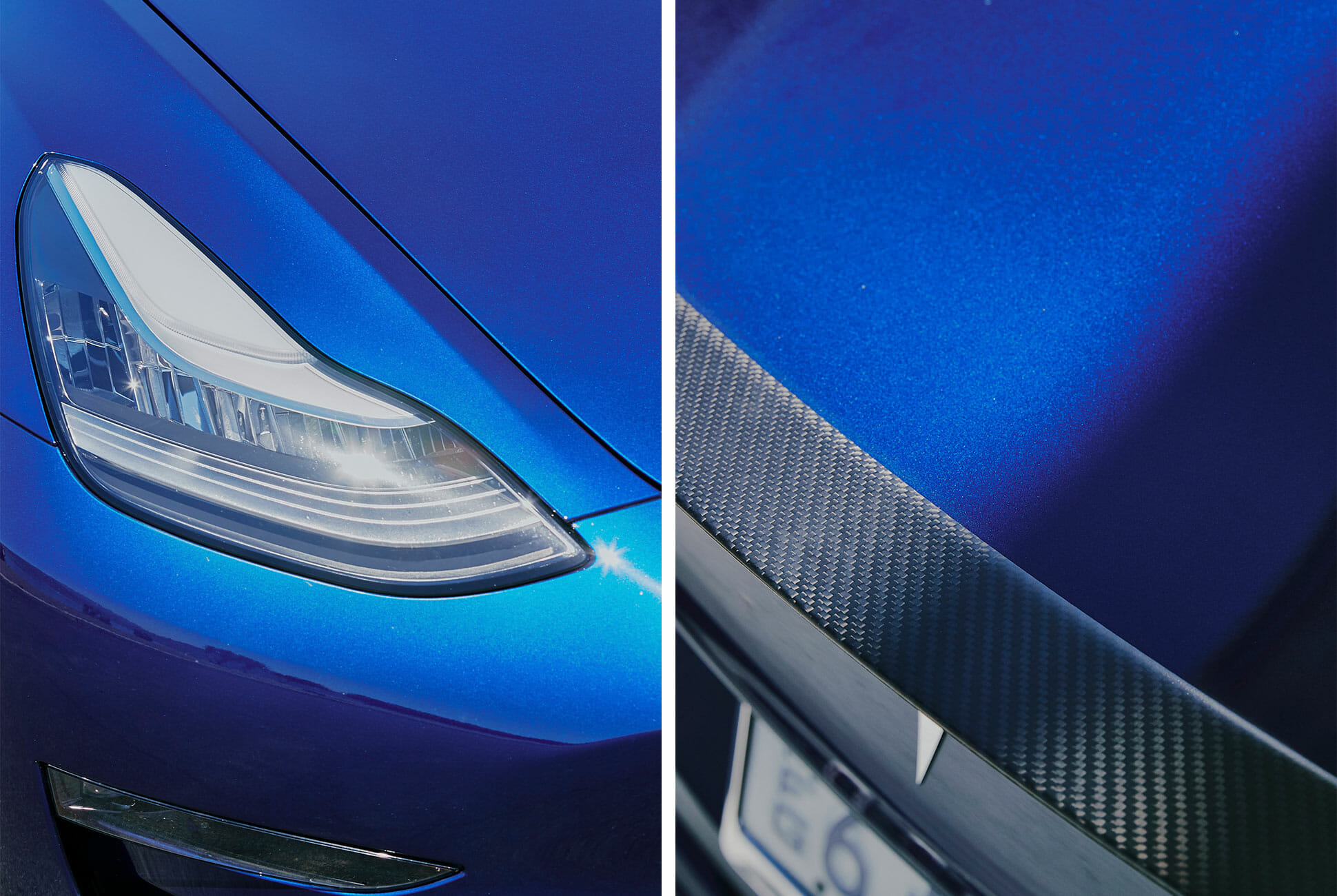
The entire car hovers into the uncanny valley between car and not-car, with a slight (no doubt purposeful) spaceship vibe. Seen in the wild, a Tesla appears slippery and dense, ovoid but aggressively planed. There is no grille because the battery-powered car has no engine; instead, there’s a wide, fat lip to lift air over the body. It turns out the car of the future is not a smooth missile like the ‘56 Oldsmobile Golden Rocket concept or a windswept stealth fighter like the 1970 Vauxhall SRV, but an expensive computer mouse with the face of a bullfrog in a wind tunnel. There is something sexy about the Model 3, but it’s not a car’s sexiness — it has the sleek, minimalist allure of a beautiful smartphone or wireless speaker.
Inside, the car is cool and hushed and almost completely unadorned under the tinted panoramic glass roof. There are no gauges, buttons, dials, knobs, switches or hidden storage compartments. There is no key — the key lives on your phone, locking and unlocking the doors automatically, among many other tasks — and no vents or speakers to be seen within the smooth, colorless expanse of vegan leather. In fact, the interior has only one feature: the Screen.
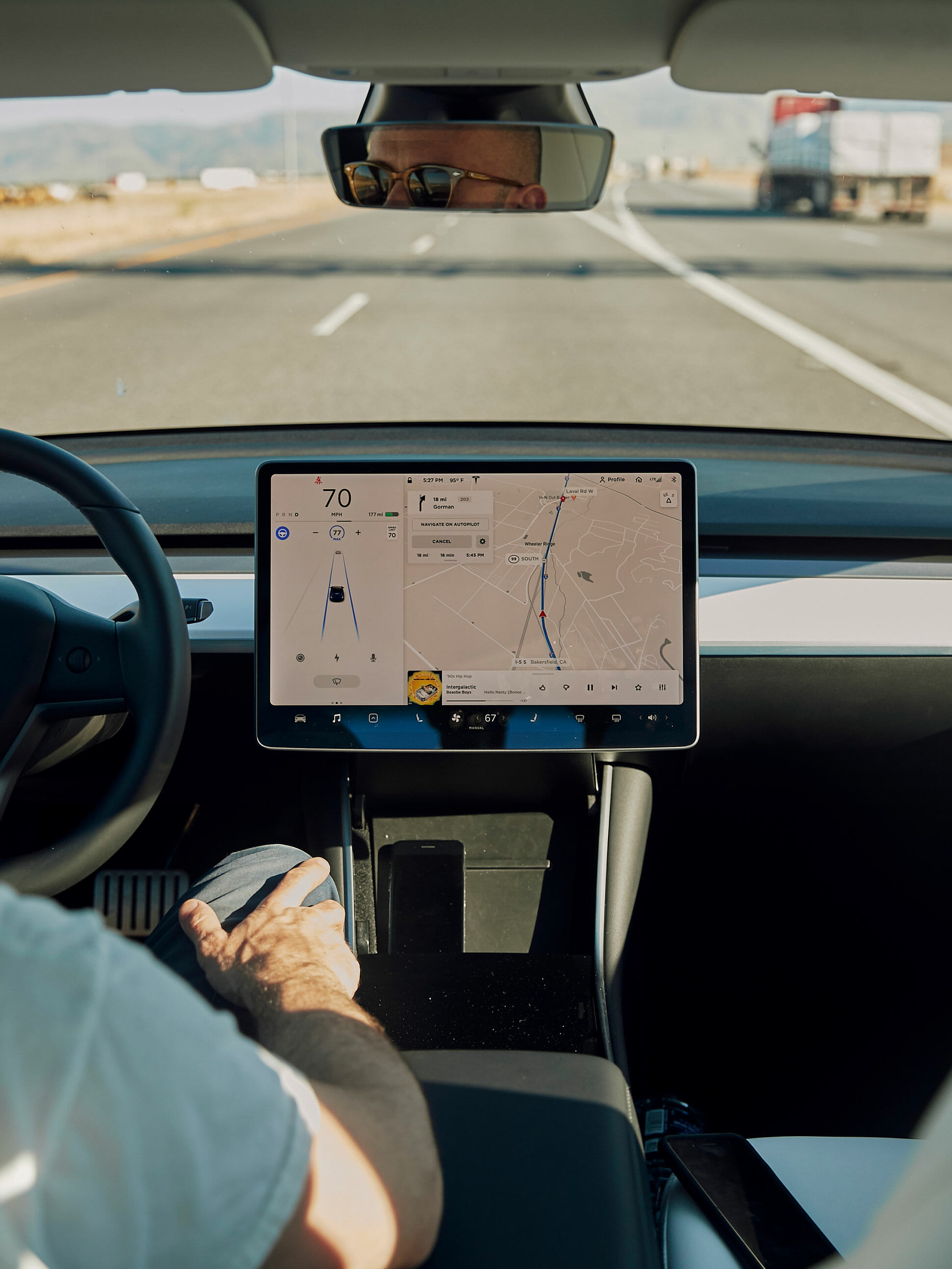
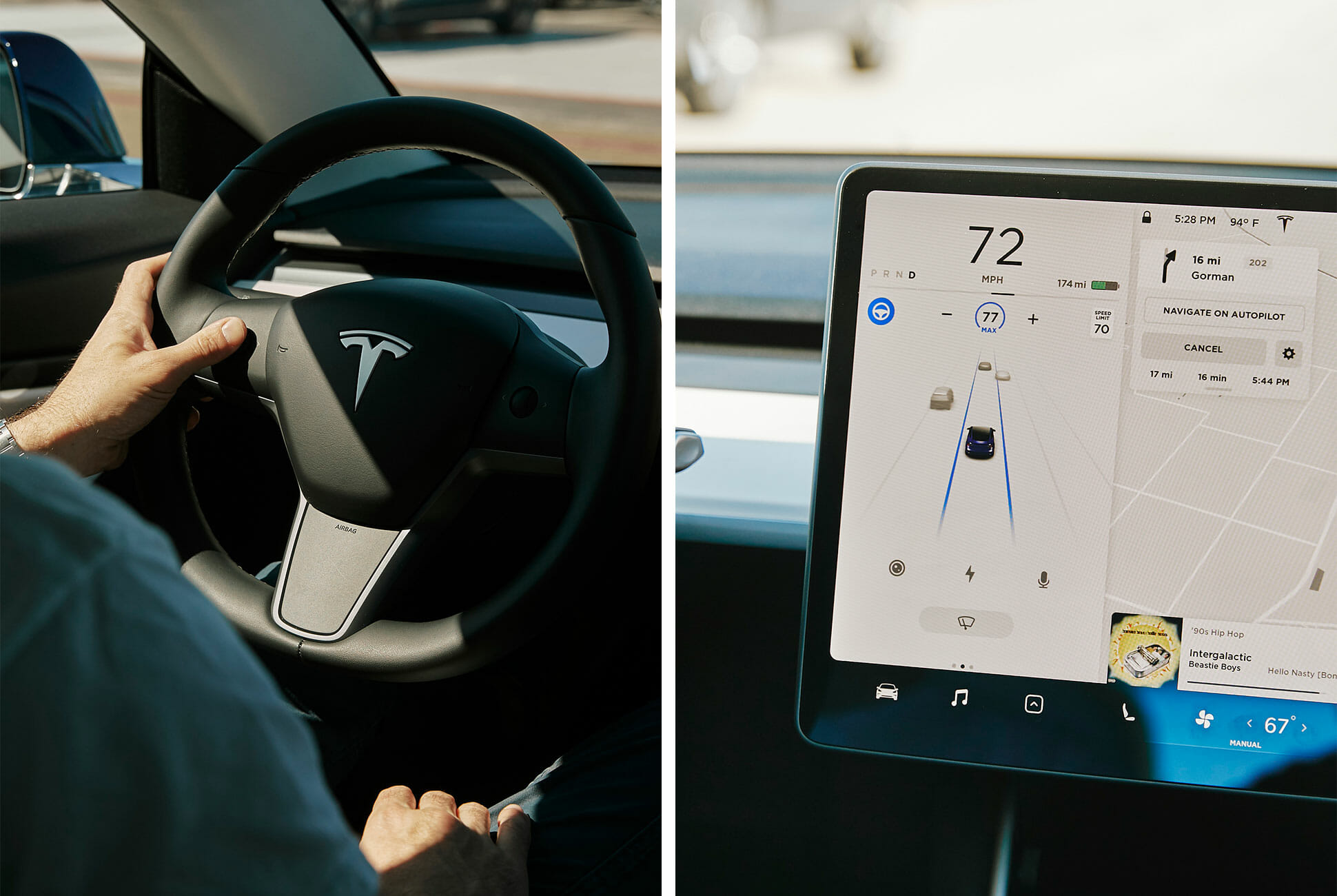
The Screen is a 15-inch horizontal tablet, the size of a platter for serving tomahawk steaks. It’s beautiful, rich in color and detail, softly glowing. Nearly every interaction with the Model 3, from the radio to the seat coolers, calls, texts, vent controls, vehicle diagnostics, security and charging port access, is done through the Screen. It feels high-tech and, at 85 mph on a six-lane highway, utterly terrifying, because there’s no way to use the huge touchscreen and its labyrinth of sub-menus without completely ignoring the road.
The Model 3 has a novel solution to the attention problem: it offers to drive. I depress a steering column-mounted stalk twice, engaging Autopilot. On the Screen, a wheel icon glows green to confirm the system is engaged. The car is now driving, using a combination of automatic cruise control, emergency braking, lane-keep assist and an assortment of additional cameras and radar sensors, and I have been relegated to monitoring status. So I sit and observe the car as it attempts to figure out things like traffic and lane closures.
For long stretches the car is utterly capable, keeping pace with traffic, navigating bends in the road, even switching lanes when I engage the turn signal. I watch the wheel juke and twitch and am struck by how little movement happens during the normal commute. For all the fidgeting, singing, eating, drinking, talking and stretching that takes place inside a car, the mundane act of commuting usually requires only the smallest, most subtle human inputs.
At other times, the Model 3 is hesitant, easily confused, at one point slowing almost to a stop on the freeway rather than accelerate past a slow-merging hatchback. On several mystifying occasions, the system tosses off an irritated bong and disengages.
As close as I can figure, Autopilot works on the highway about as well as a nearsighted 12-year-old, which on the one hand qualifies it as a staggering technological achievement and on the other means I’m hardly tempted to take a nap while it’s in charge. Still, I find myself surprisingly willing to let Autopilot take the wheel for a spell, when I’m sleepy or bored or I just want to play with a bright glowing screen for a minute. Hell, that squinty bugger got us most of the way to Tesla’s Kettleman City Superchargers three hours south, and it planned the whole route to boot.
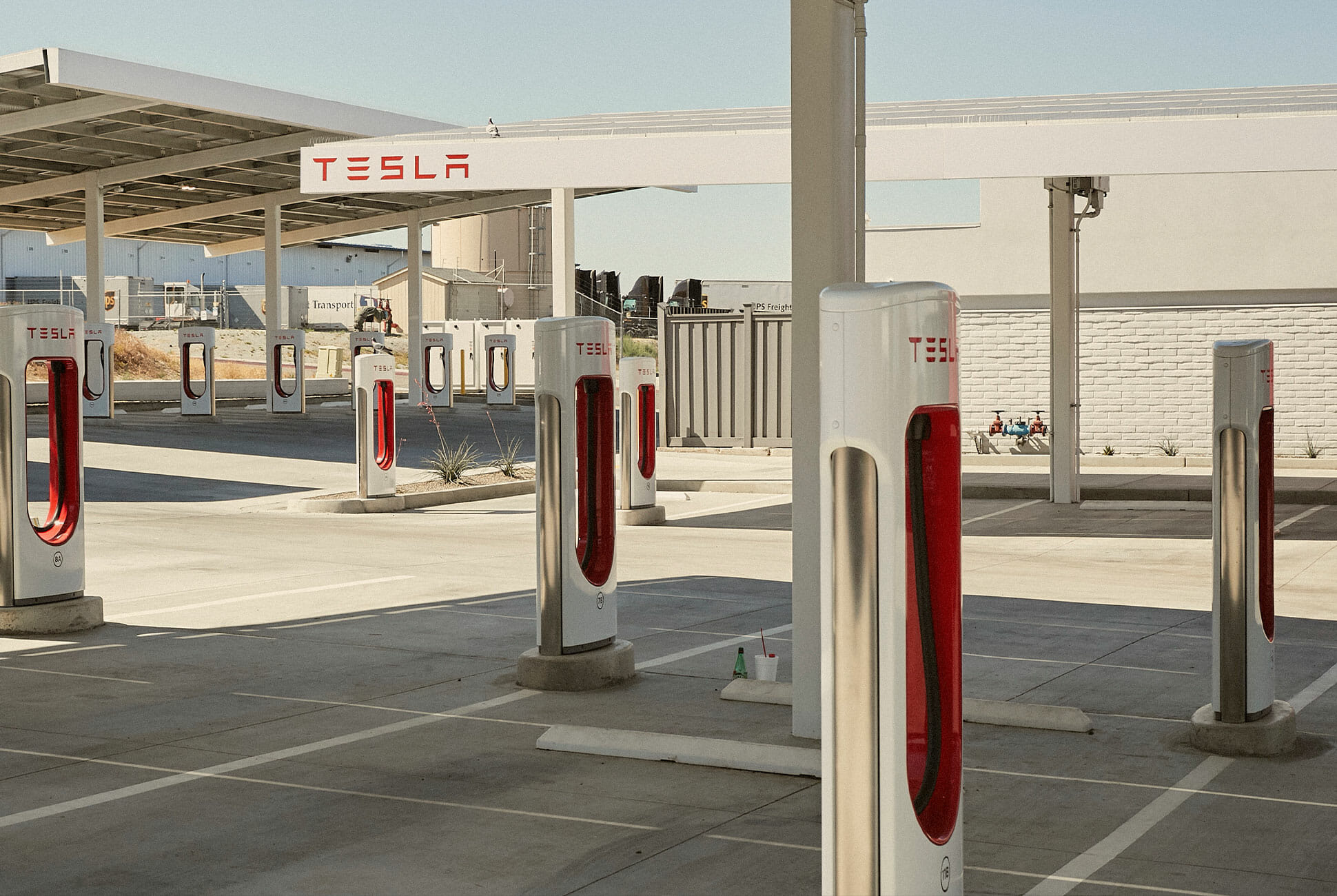
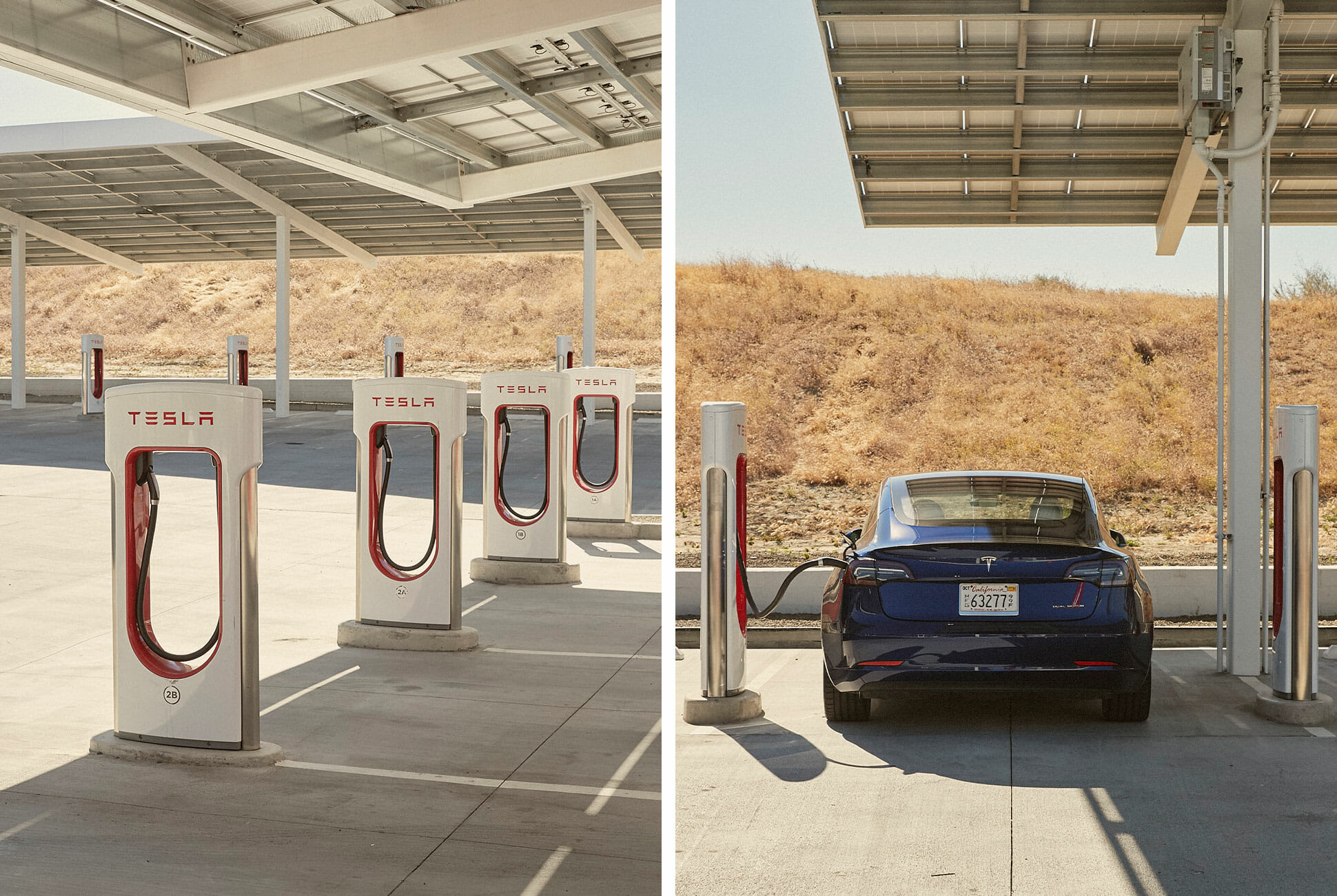
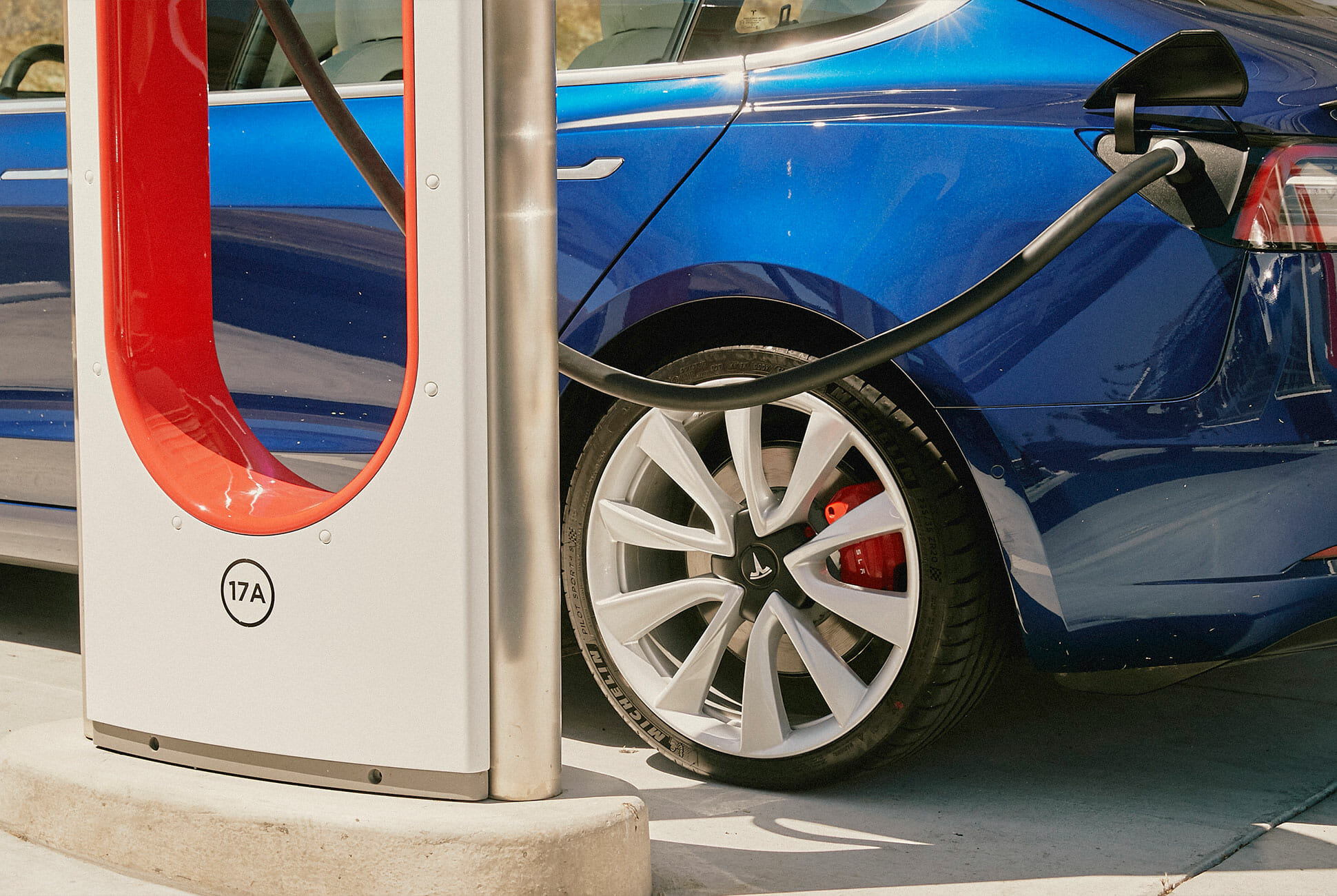
The grass outside the Kettleman City Supercharging station is very green and all the blades are exactly the same height, because it’s fake. The door is locked with a keypad; when you arrive, your phone key sends the passcode to unlock it. It’s spacious and cool inside, with a barista selling espresso drinks, a playpen for kids, plentiful outlets and comfortable chairs for efficient telecommuting, like a business class airport lounge in Burbank.
It’s comfortable enough to spend an hour and 14 minutes, precisely how long the phone key tells me it will take to recharge, but there’s an In-N-Out Burger within walking distance so time is passed there, instead. I track the charging on my phone and time my return exactly to the moment it’s complete.
The Model 3 delivers me back to LA in around seven hours, including the charging, and I’m about as fresh when I get out of the car as when I got in. This is the great shouted promise of the autonomous, electric, connected vehicle: the car will do the work for you — and it will, and it will delight and amaze. The only catch is that the car needs to remove you from the decision-making equation when it sees fit, and you get no say.
The starkest example of what we’ll give up in our artificially intelligent future is this: you can drive that old Merc straight into a wall as fast as your courage and runway allow, but the Tesla won’t let you do it. Neither will a modern Mercedes, or Volvo, or anything with emergency braking. The simple computers that controlled things like electronic fuel injection (quicker acceleration, on demand!) have grown so powerful they now outrank the human driver. Computers determine how much throttle the car uses and how much steering, when to add to or subtract from your speed. I spent a lot of time in the Model 3 wrestling with the steering wheel, trying to determine who’s in charge. It’s not an argument I can win.
In the car of the future, the need to drive will be replaced with the freedom to answer emails. The car will give you the feeling of escape but will never stop watching you, never let you truly get lost. It can seem a sad, silly thing to mourn the ability to run a car headlong into a wall because you want to, but freedom lost is often lost forever, and it requires mourning all the same.
